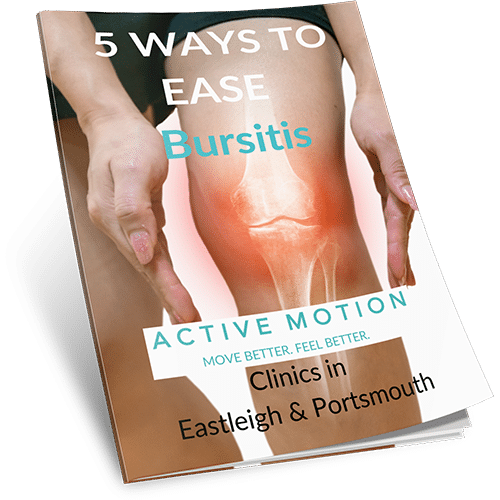Get Relief From Bursitis Pain With Our Expert Physiotherapy Care
- Conveniently located in Portsmouth
- Portsmouth Clinic: Active Motion Injury Clinic Jetts 24hr Fitness, Anchorage Rd, Portsmouth PO3 5SA
- Monday - Friday - 8:00am - 6.00pm
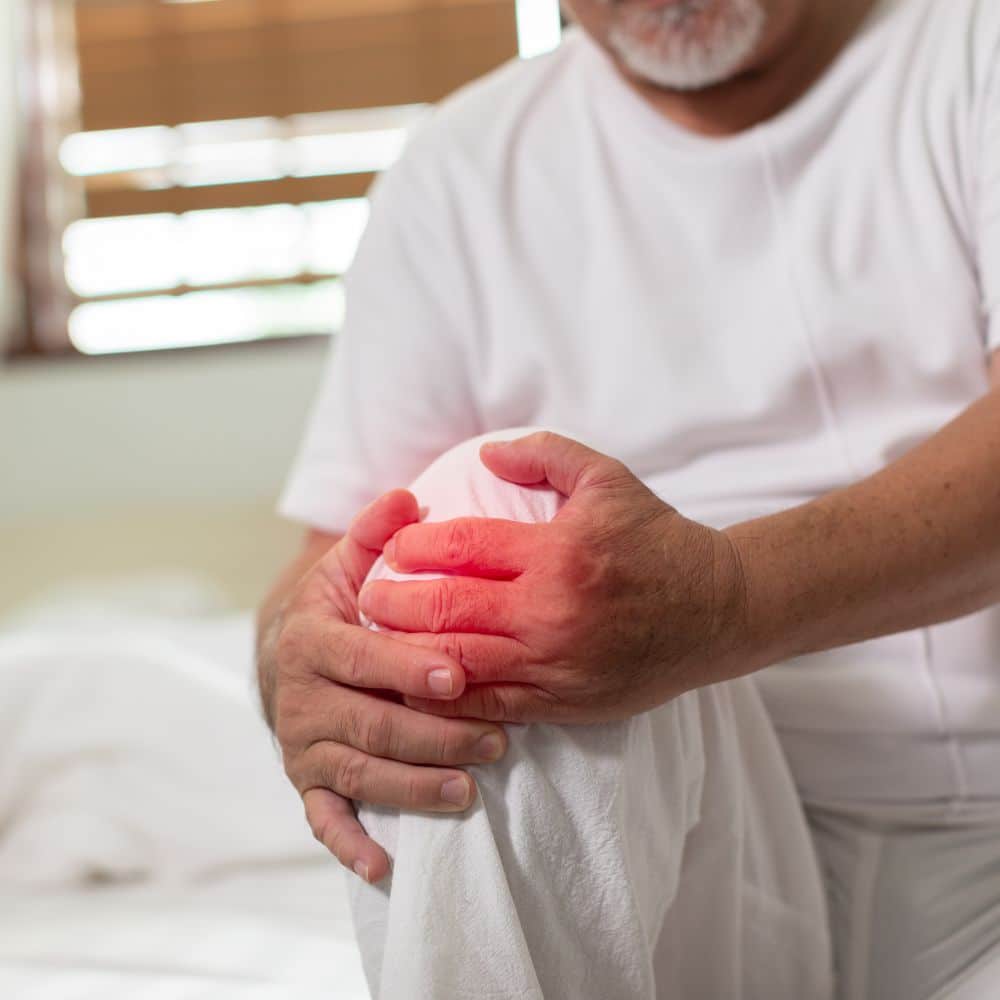
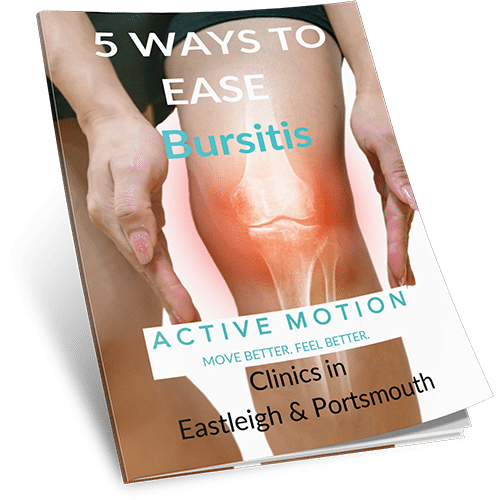
Download Your FREE Bursitis Pain Guide:
"5 Ways To Ease Bursitis Pain"
- Click the button below to get your FREE Guide
Physiotherapy care along with specialized treatments for patients of all ages.
Does any of this sound familiar?
- Do you experience Bursitis Pain when you get up in the morning or after sitting for a while?
- Have you visited multiple clinics, but still can't find relief from your Bursitis Pain?
- Have you invested a lot of money in treatment that didn't alleviate your Bursitis Pain?
- Are you avoiding exercise due to the fear of aggravating your Bursitis Pain?
- Are you starting to worry that you'll never recover from your Bursitis Pain and won't be able to enjoy the activities you love?
- Has a medical professional suggested that surgery, painkillers and injections are the next step in treating your Bursitis Pain?
Active Motion Injury Clinic
Got a Question?
Ask Active Motion Injury Clinic And Our Team Of Expert Physiotherapists
What Causes Bursitis Pain?... And Why is My Bursitis Pain Not Getting Better?
Bursitis pain happens for a few common reasons:
Repetitive motions or overuse of a joint
Prolonged pressure on a joint
Sudden injury or impact to a joint
Poor posture or biomechanics
Underlying muscle imbalances or joint instability
Aging and wear-and-tear on joints
Inflammatory conditions like rheumatoid arthritis
Infection (in rare cases, septic bursitis)
Why is my bursitis pain not getting better?
You haven’t identified or removed the activity causing irritation
Your rehab program isn’t addressing the surrounding muscles and joint mechanics
Inflammation continues due to repetitive stress or poor recovery habits
The affected area isn’t getting proper rest, support, or mobility work
There may be compensations in nearby joints
Improper posture or daily habits are aggravating the bursa
The condition has become chronic without consistent, targeted intervention
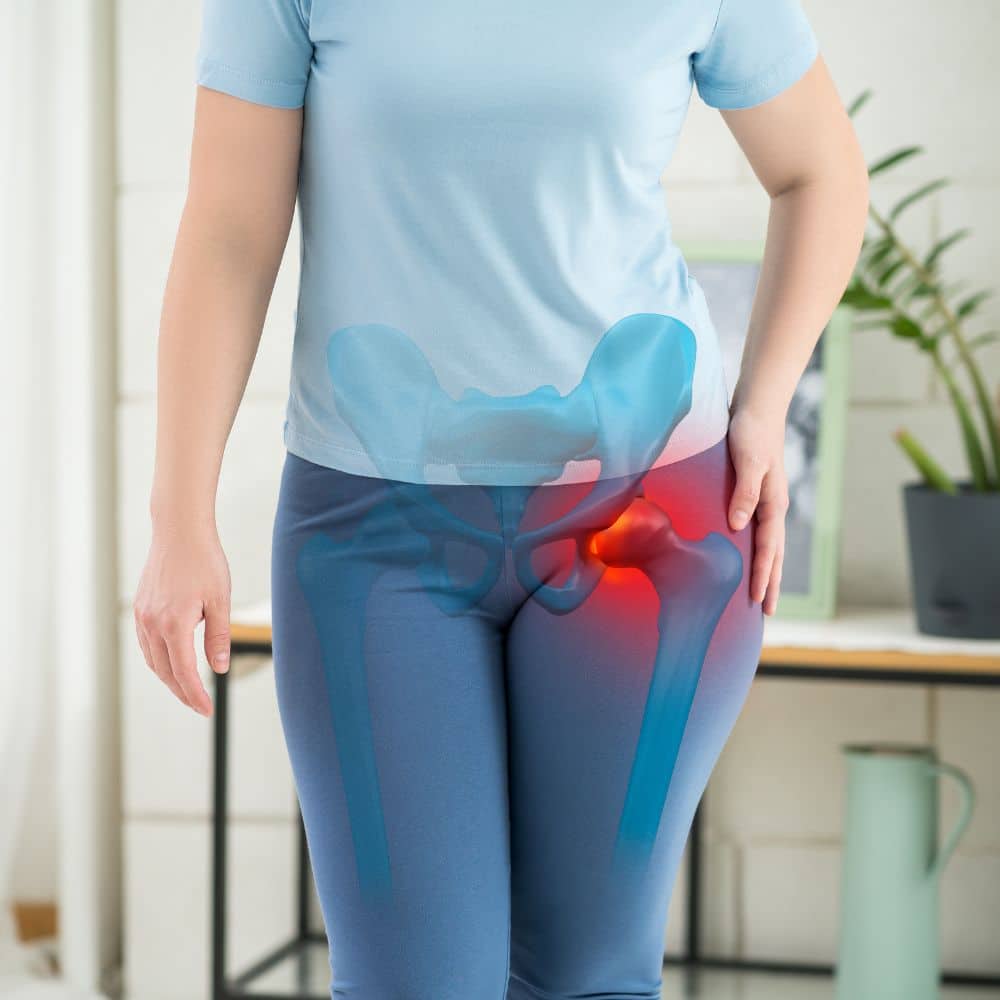
Tired of Living with Bursitis Pain? We Can Help

- Fill in the form to request a Call From Our Team Of Expert Physiotherapists
- One of our team members will call you for FREE and answer any questions or concerns you may have about your Bursitis Pain
What Are The Symptoms of Bursitis Pain?

Recognising the signs of bursitis early can help you take action before inflammation becomes chronic. Symptoms can vary depending on the joint affected (hip, shoulder, elbow, or knee), but here are the most common warning signs to look out for:
Localised pain near a joint that worsens with movement or pressure
Swelling or visible puffiness over the joint
Stiffness or limited range of motion
Tenderness when pressing on the area
Warmth or redness over the affected site
Pain that feels sharp during activity and aching at rest
Increased pain in the morning or after prolonged inactivity
Difficulty performing daily tasks (e.g., walking, lifting, or reaching)
Pain that flares up with repetitive motion or direct pressure
Is Physiotherapy Right For Your Bursitis Pain?
- Our team at Active Motion Injury Clinic are experts in joint and soft tissue pain—helping hundreds of patients get back to walking, moving, and living without the daily limitations that bursitis can cause.
Here’s just a few of the things our Team can do for you:
- We can help relieve pain and reduce inflammation, often within just a few sessions by addressing the irritated bursa and surrounding tissues.
- From your very first visit, we’ll explain what’s causing your bursitis pain—why it’s happening and what steps are needed to resolve it—so you feel clear and confident about your recovery.
- We’ll help uncover the root cause of your bursitis, whether it’s poor movement mechanics, muscle imbalances, or repetitive strain—and build a personalised treatment plan.
-
Our treatments can help restore comfort, mobility, and strength, so you can walk, bend, lift, or sit without flare-ups.
- We can help you avoid long-term use of painkillers by offering natural, movement-based solutions backed by evidence.
- Our goal is to help you avoid injections or surgery, getting to the source of the problem with targeted, hands-on treatment.
- You’ll skip repeated GP visits with one-on-one sessions that are built around your needs—not rushed, generic advice.
- We want to help you reclaim time with your family, career, or favourite hobbies—without bursitis pain holding you back.
- Ultimately, we’ll help you stay active and enjoy a pain-free life, free from the fear of flare-ups or chronic irritation.
What’s next? You’ve got a decision to make – another month gone without solving your Bursitis Pain problem, or are you ready to get back to doing the things you love?
Why Patients Choose Us:
Having served the people of Portsmouth and receiving overwhelming feedback from patients as to why they choose us include:
- Award Winning Patient Care
- Early morning and evening availability
- Gentle, safe and effective health care
- Free Discovery Visits
- Highly trained and caring staff
Frequently Asked Questions About Bursitis Pain
Bursitis is commonly caused by repetitive movements, prolonged pressure on a joint (such as kneeling or leaning on elbows), trauma, poor posture, joint misalignment, or underlying conditions like arthritis. It frequently affects the shoulder, hip, elbow, or knee.
A more serious case of bursitis may involve ongoing swelling, warmth, redness over the joint, significant pain with movement or touch, or difficulty using the affected limb. If symptoms don’t improve after a few days, or if daily tasks become difficult, it’s time to seek professional help.
You should see a physiotherapist if the pain continues for more than a few days, becomes more severe, or starts to interfere with your ability to move, work, or carry out everyday activities. Early intervention can prevent the issue from becoming long-term.
Recovery from bursitis varies depending on the joint affected and how long the problem has been present. With proper physiotherapy, many people see improvements within a few weeks, though chronic or stubborn cases may take longer.
Yes, but it’s important to exercise carefully. Certain movements may aggravate the inflammation, so a physiotherapist can help you choose safe stretches and low-impact exercises that support healing without placing stress on the affected area.
You can reduce your risk of bursitis by improving your posture, using good technique when lifting, avoiding repetitive strain, staying active, and strengthening the muscles around your joints. Take care to avoid prolonged pressure on joints—especially when kneeling or leaning.
Recurring bursitis is often due to unresolved issues such as poor posture, joint instability, or repeated strain. If the underlying cause isn’t addressed, flare-ups may continue. Physiotherapy helps correct these issues and build resilience to prevent it happening again.
Are You Struggling With Bursitis Pain? Take Us Up on One of Our FREE Options
Active Motion Injury Clinic
- Jetts 24hr Fitness, Anchorage Rd, Portsmouth PO3 5SA
- +44 7700 151209
- activemotioninjuryclinic@gmail.com
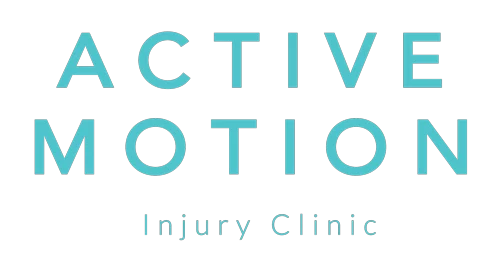
© Copyright 2025 Active Motion Injury Clinic. All Rights Reserved.

